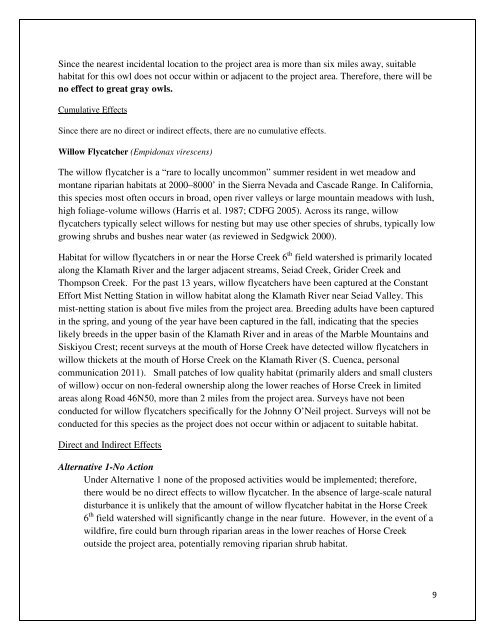Johnny O'Neil Late Successional Reserve Habitat Restoration and ...
Johnny O'Neil Late Successional Reserve Habitat Restoration and ...
Johnny O'Neil Late Successional Reserve Habitat Restoration and ...
You also want an ePaper? Increase the reach of your titles
YUMPU automatically turns print PDFs into web optimized ePapers that Google loves.
Since the nearest incidental location to the project area is more than six miles away, suitable<br />
habitat for this owl does not occur within or adjacent to the project area. Therefore, there will be<br />
no effect to great gray owls.<br />
Cumulative Effects<br />
Since there are no direct or indirect effects, there are no cumulative effects.<br />
Willow Flycatcher (Empidonax virescens)<br />
The willow flycatcher is a “rare to locally uncommon” summer resident in wet meadow <strong>and</strong><br />
montane riparian habitats at 2000–8000’ in the Sierra Nevada <strong>and</strong> Cascade Range. In California,<br />
this species most often occurs in broad, open river valleys or large mountain meadows with lush,<br />
high foliage-volume willows (Harris et al. 1987; CDFG 2005). Across its range, willow<br />
flycatchers typically select willows for nesting but may use other species of shrubs, typically low<br />
growing shrubs <strong>and</strong> bushes near water (as reviewed in Sedgwick 2000).<br />
<strong>Habitat</strong> for willow flycatchers in or near the Horse Creek 6 th field watershed is primarily located<br />
along the Klamath River <strong>and</strong> the larger adjacent streams, Seiad Creek, Grider Creek <strong>and</strong><br />
Thompson Creek. For the past 13 years, willow flycatchers have been captured at the Constant<br />
Effort Mist Netting Station in willow habitat along the Klamath River near Seiad Valley. This<br />
mist-netting station is about five miles from the project area. Breeding adults have been captured<br />
in the spring, <strong>and</strong> young of the year have been captured in the fall, indicating that the species<br />
likely breeds in the upper basin of the Klamath River <strong>and</strong> in areas of the Marble Mountains <strong>and</strong><br />
Siskiyou Crest; recent surveys at the mouth of Horse Creek have detected willow flycatchers in<br />
willow thickets at the mouth of Horse Creek on the Klamath River (S. Cuenca, personal<br />
communication 2011). Small patches of low quality habitat (primarily alders <strong>and</strong> small clusters<br />
of willow) occur on non-federal ownership along the lower reaches of Horse Creek in limited<br />
areas along Road 46N50, more than 2 miles from the project area. Surveys have not been<br />
conducted for willow flycatchers specifically for the <strong>Johnny</strong> O’Neil project. Surveys will not be<br />
conducted for this species as the project does not occur within or adjacent to suitable habitat.<br />
Direct <strong>and</strong> Indirect Effects<br />
Alternative 1-No Action<br />
Under Alternative 1 none of the proposed activities would be implemented; therefore,<br />
there would be no direct effects to willow flycatcher. In the absence of large-scale natural<br />
disturbance it is unlikely that the amount of willow flycatcher habitat in the Horse Creek<br />
6 th field watershed will significantly change in the near future. However, in the event of a<br />
wildfire, fire could burn through riparian areas in the lower reaches of Horse Creek<br />
outside the project area, potentially removing riparian shrub habitat.<br />
9
















